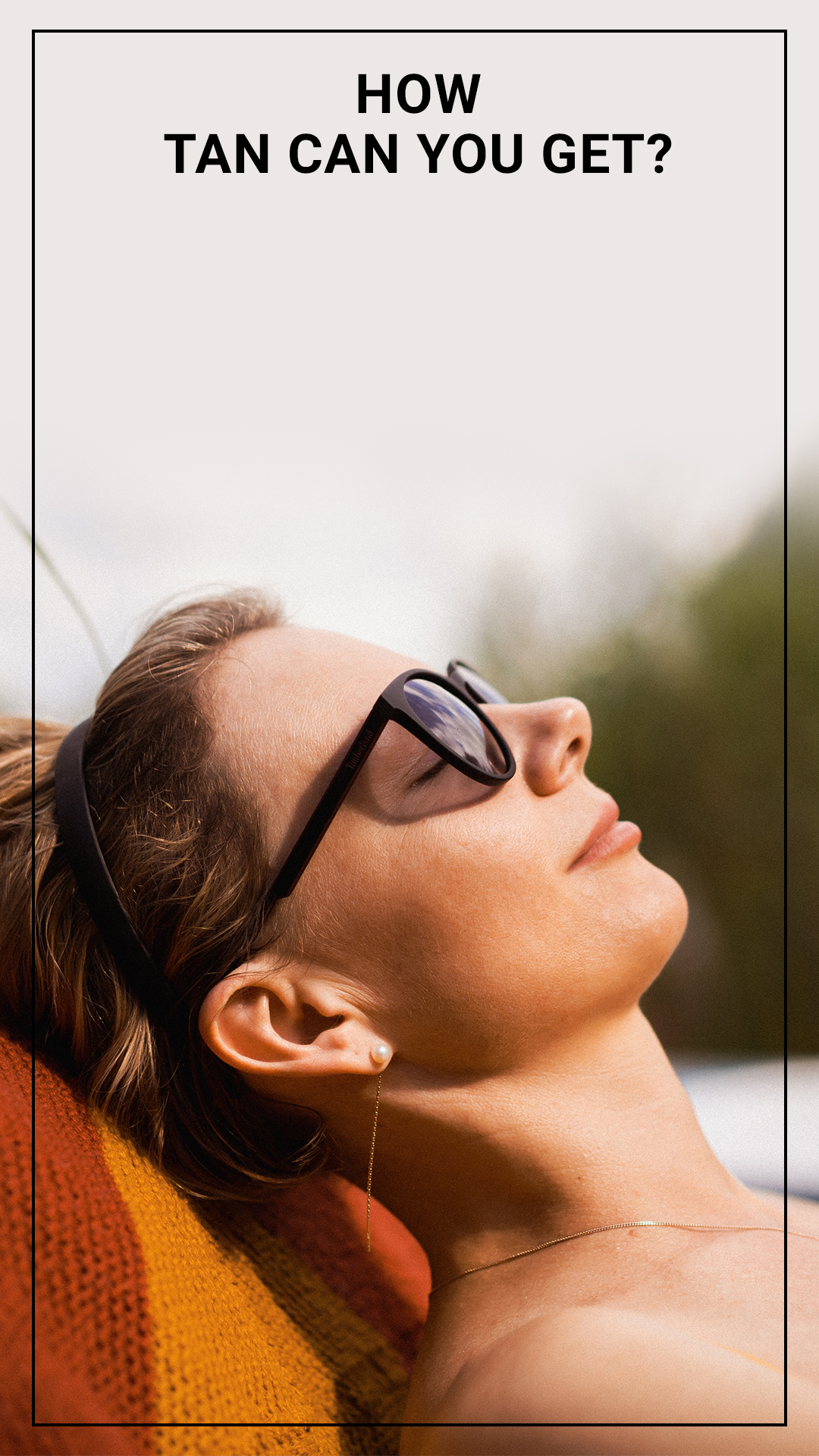
Important: This article is for informational purposes only. Please read our full disclaimer for more details.
Tanning helps to get a sun-kissed glow. It gives a gorgeous golden bronze shade to the skin that looks amazing, especially on people with pasty white skin tone.
Tanned skin doesn’t develop overnight. It is a gradual process and takes many sessions under the sun or in the tanning bed to get the desired skin tone. However, people notice that after some time, their skin is not tanning anymore, which means their skin is not getting any darker.
If you also wonder how tan can I get, the answer is it all depends upon your skin type.
How To Get a Tan Safely?
Dermatologists classify skin into six main types, each of which tans to different levels before they stop tanning. It is called a tanning plateau.
If you know your skin type, it will help to understand how tan you can get and what is your potential tan limit. Besides skin type, many other factors also play a role in deciding your tan limit. Keep reading to find answers to all your queries.
Different Skin Tones And Their Different Tan Limits
Among all the factors that contribute to tanning limits, skin tone plays a major role. The skin contains melanin, the compound responsible for giving color or pigment to your skin. As the skin is exposed to UV rays, it comes in defense mode and produces more melanin to provide protection.
As the melanin content increases, the skin darkens, leading to tan development.
Another thing that needs to be mentioned is the types of melanin-
- Eumelanin- brown pigment
- Pheomelanin- yellow and red pigment
People with fair skin produce pheomelanin when they come in contact with UV rays. Their skin produces very little eumelanin, which is why fair-skinned people struggle to develop tan and often burn instead.
As Per FDA- There Are Six Skin Types
Skin Type 1- People with pale white and very fair skin tones come under this category. They often have lots of freckles and blue or gray eyes. It is very hard for people with such skin type to get tan.
Sitting under the sun will only make their skin burn. Therefore, basking under the sun or tanning bed is strictly prohibited.
Skin Type 2- People with white to beige and fair skin tone falls under this category. It is possible to find freckles in such people, blonde to brown hair, and green to gray eyes. With this skin type, a tan may develop, but it is minimal.
The chances of sunburn are typically high. Therefore, such people should take extra care of their skin while attempting to tan.
Skin Type 3- People who have beige to fair to light brown skin tone are in this category of skin type. They do not have freckles and often experience moderate burning in the sun. Such people may tan gradually and develop light brown color. But, beyond this is not possible.
It is advised to protect their skin from overexposure to the sun and keep the tanning period minimum.
Skin Type 4- If you have light brown skin with dark brown hair and eyes, you are Skin Type 4. Such people get sunburned minimally and develop a moderate brown tan from sun exposure.
Skin Type 5- People with moderate brown to deep brown skin tone, dark eyes, and hair fall under the Skin Type 5 category. Such people rarely burn in the sun and easily develop a dark brown tan when exposed to the sun’s rays for a few minutes.
Skin Type 6- People with dark brown to black skin tone, black hair, and dark eyes are Skin Type 6. It is very hard for such people to get sunburned. Instead, their skin tans really well. Dark-skinned people are blessed with the best natural protection against the sun.
Besides skin types, here are some other factors that play a role in deciding how tan one can get-
- if you have stopped spending too much time in the sun
- your skin has become thicker due to excessive tanning
Natural tan develops only when the skin is exposed to UV rays. So, if you are not going out, the possibility of your skin getting tanned reduces to zero.
Likewise, if your skin has tanned too much, it becomes thick because a coat of dead skin cells accumulates, giving the dark skin tone. In such cases, it becomes hard for UV rays to penetrate further.
Tan is proof that your skin has been damaged. According to dermatologists, tanning is not a safe procedure and is health hazardous. However, people love getting tanned due to cosmetic reasons.
Even if you have developed a tan and not a burn, it indicates your skin has come under huge stress. So, if you notice that your skin is not getting tanned at all (because you are a Skin Type 1 or 2) or not getting tanned further (because you have tanned previously), it is better to avoid sitting under the sun.
Attempts to tan further will only damage the skin and make it prone to dreadful diseases like skin cancer.
How Can I Get Tan?
If the summers are approaching and our eagerness to get a sun-kissed glow has peaked, it’s high time to know the different ways to get tan.
1. Natural Sun Tan
It is the most natural way to develop a golden bronze glow on the skin. At the same, it helps the body process Vitamin D. However, before attempting to suntan, ensure you wear sun protection to keep the skin safe from damage and reduce the risk of sunburn, dehydration, premature skin aging, and eye damage.
Apply a broad-spectrum sunscreen with an SPF of at least 30 that prevent sunburn yet allows suntan. If you want to tan fast, bask under the sun between 12 PM to 3 PM. However, if you are fair-skinned, avoid this time to prevent sunburn.
2. Tanning Beds
People who can’t afford to bask under the sun for hours can opt for tanning beds to develop a tan. 20 minutes spent in a tanning bed is equal to 2 hours spent under the sun.
Tanning beds emit stronger UV radiations that work fast in helping you develop a tan. However, you need to schedule different sessions within a week and thereafter to maintain tan for longer.
Since tanning beds emit stronger UV rays, the chances of skin damage are also high. Therefore, taking all the preventive measures before entering a tanning bed is essential.
3. Using Sunless Self-tanner
Self-tanners come in different forms- lotions, creams, and sprays. All of these consist of tanning solution that has DHA- dihydroxyacetone as the active ingredient.
As a self-tanner is applied to the skin, it reacts with the amino acids present in the uppermost layer, causing skin cells to get dark. Tanning through self-tanners is a temporary process; the results don’t last longer than a week.
Even though you can escape sun exposure with self-tanners, excessive use of DHA can make the skin prone to premature aging. Therefore, it should be used occasionally.
4. Spray Tan
Spray tanning is another way of sunless tanning, usually done inside a spray tanning booth. The tanning solution in the spray consists of DHA, which works similarly to self-tanners.
For spray tanning, you must visit the salon that provides this service. Generally, it takes around 30 minutes to complete one spray tanning session. To maintain the tan developed through this, many successive sessions are needed.
5. Bronzing Lotions
Bronzing lotion also comes under sunless tanning and is perfect for those looking for a quicker tan than any other self-tanning method.
There are two types of bronzing lotions- DHA lotions and natural bronzing lotions. While DHA lotions consist of DHA as the major and active ingredient that develop a tan, the natural bronzing lotion has components that help boost melanin production in the skin.
To add an extra glow to these fake tans, bronzer makeup in stick, powder, or gel form can be used.
Final Words
How tan can you get is mainly determined by your skin tone. Lighter skin tones have less melanin; therefore, they do not tan but burn. Dark skin tones have high melanin, providing high protection from the sun and helping develop tan faster.
Now that you know the different methods to develop a tan choose the one that fits your lifestyle and comfort. It’s time to look gorgeous in the coming summer season.
You Might Also Like
- Does Being Tan Makes You Look Skinnier?
- Does Your Skin Stop Tanning At A Certain Point?
- Can You Still Get A Tan from Clouds?
- Can You Get Tan In The Shade
- How to Tan with Fair Skin and Freckles?
- Can You Get A Tan Through A Window?
- Can You Tan In The Winter?
- Can You Tan With Makeup On
Image Credit: freepik



















